climate control INFINITI Q60 COUPE 2021 User Guide
[x] Cancel search | Manufacturer: INFINITI, Model Year: 2021, Model line: Q60 COUPE, Model: INFINITI Q60 COUPE 2021Pages: 492, PDF Size: 2.44 MB
Page 217 of 492
![INFINITI Q60 COUPE 2021 User Guide (P.2-46).)
.[A/C]
Touch to turn the air conditioner on/off.
(See “Automatic operation (AUTO)”
(P.4-36).)
.[Auto Recirc] (if so equipped)
Touch to turn the auto-recirculation
mode on/off. (See “A INFINITI Q60 COUPE 2021 User Guide (P.2-46).)
.[A/C]
Touch to turn the air conditioner on/off.
(See “Automatic operation (AUTO)”
(P.4-36).)
.[Auto Recirc] (if so equipped)
Touch to turn the auto-recirculation
mode on/off. (See “A](/img/42/35059/w960_35059-216.png)
(P.2-46).)
.[A/C]
Touch to turn the air conditioner on/off.
(See “Automatic operation (AUTO)”
(P.4-36).)
.[Auto Recirc] (if so equipped)
Touch to turn the auto-recirculation
mode on/off. (See “Advanced Climate
Control System” (P.4-39).)
.[
]or[] (if so equipped)
Touch to turn the seat heater on/off.
(See “Heated seats” (P.2-45).)
DUAL mode setting
Touch [DUAL] to turn on/off the DUAL
mode. When the DUAL mode is set, the
temperature for the driver seat and the front
passenger seat can be adjusted indepen-
dently. When the DUAL mode is on, the
indicator light is on and “DUAL” appears.
Advanced Climate Control System
(if so equipped)
The Advanced Climate Control System
keeps the air inside of the vehicle clean,
using the automatic air circulation control
with the exhaust gas/outside odor detection
sensor and with ion control.
WAE0219X
[Auto Recirc]:
Touch to turn on the automatic air
recirculation mode.
Plasmacluster®icon:
Indicates the Plasmacluster®ion emis-
sion status.
Automatic air recirculation control with the
exhaust gas/outside odor detection sensor:
The Advanced Climate Control system
comes with an exhaust gas detection/out-
side odor sensor. When the automatic air
circulation control is activated, the sensor
detects odors outside the vehicle such as
pulp or chemicals, and exhaust gas such as
gasoline or diesel. When such odors or gases
are detected, the display and the systemautomatically change from the fresh air
mode to the recirculation mode.
When the automatic air circulation control
mode is on, for the first 5 minutes, the air
recirculation mode is selected to prevent
dust, dirt and pollen from entering the
vehicle and to clean the air inside of the
vehicle.
After 5 minutes, the sensor detects exhaust
gas and automatically alternates between
the air recirculation mode and the fresh air
mode.
NOTE:
The automatic air recirculation mode can be
activated under the following conditions.
.The air flow control is not in the wind-
shield defrosting mode (the indicator
light on
is turned off).
.The outside temperature is approxi-
mately 32 °F (0 °C) or above.
Ion control:
The Advanced Climate Control system unit
generates highly concentrated Plasmaclus-
ter
®ions into the air blown from the
ventilators to reduce odor absorbed into
the interior trim and to suppress airborne
bacteria. The high-density Plasmacluster
®
ions also have a proven skin moisture
preserving effect.
Monitor, climate, audio, phone and voice recognition systems4-39
Page 218 of 492

4-40Monitor, climate, audio, phone and voice recognition systems
The Plasmacluster®icon on the climate
screen indicates the status of the Plas-
macluster
®ion emission from the system
and changes with the amount of the air flow.
CLIMATE SETTINGS
Climate settings can be changed on the
climate settings screen on the lower display.
1. Push the MENU button and touch [Set-
tings] on the lower display.
2. Touch [Others].
3. Touch [Climate].
The displayed keys on the lower display may
vary depending on models, specifications
and software versions.
Available settings:
.Left/Right Seat Heater
The driver’s seat and front passenger
seat temperature settings for the auto-
matic seat heating control mode can be
changed separately. (See “Heated seats”
(P.2-45).)
.Steering Wheel Heater
The steering wheel heater can be turned
on/off. (See “Heated steering wheel”
(P.2-46).)
.Auto Steering Wheel Heater
The automatic control mode for the
steering wheel heater can be turned
on/off. When this item is turned on, thesteering wheel heater will turn on auto-
matically if the temperature inside the
vehicle compartment is low at the time
when the ignition switch is turned on.
Regardless of the temperature, the
steering wheel heating will turn off after
30 minutes.
If the steering wheel heater is manually
turned on/off by touching [Steering
Wheel Heater] on the climate settings
screen, the automatic steering wheel
heating control mode will be canceled
and the system will return to the manual
mode.
NOTE:
If the surface temperature of the steer-
ing wheel is above the temperature at
which the system is designed to operate,
the system will not heat the steering
wheel. This is not a malfunction.
5GC0006X
JVH0520X
OPERATING TIPS
When the engine coolant temperature and
outside air temperature are low, the air flow
from the foot outlets may not operate.
However, this is not a malfunction. After
the coolant temperature warms up, the air
flow from the foot outlets will operate
Page 219 of 492
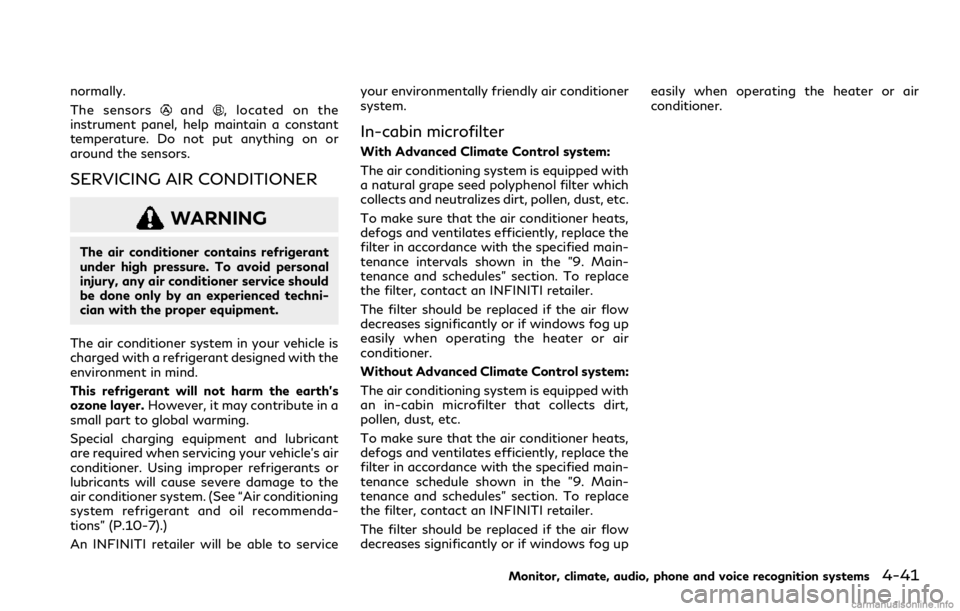
normally.
The sensors
and, located on the
instrument panel, help maintain a constant
temperature. Do not put anything on or
around the sensors.
SERVICING AIR CONDITIONER
WARNING
The air conditioner contains refrigerant
under high pressure. To avoid personal
injury, any air conditioner service should
be done only by an experienced techni-
cian with the proper equipment.
The air conditioner system in your vehicle is
charged with a refrigerant designed with the
environment in mind.
This refrigerant will not harm the earth’s
ozone layer.However, it may contribute in a
small part to global warming.
Special charging equipment and lubricant
are required when servicing your vehicle’s air
conditioner. Using improper refrigerants or
lubricants will cause severe damage to the
air conditioner system. (See “Air conditioning
system refrigerant and oil recommenda-
tions” (P.10-7).)
An INFINITI retailer will be able to serviceyour environmentally friendly air conditioner
system.
In-cabin microfilter
With Advanced Climate Control system:
The air conditioning system is equipped with
a natural grape seed polyphenol filter which
collects and neutralizes dirt, pollen, dust, etc.
To make sure that the air conditioner heats,
defogs and ventilates efficiently, replace the
filter in accordance with the specified main-
tenance intervals shown in the "9. Main-
tenance and schedules" section. To replace
the filter, contact an INFINITI retailer.
The filter should be replaced if the air flow
decreases significantly or if windows fog up
easily when operating the heater or air
conditioner.
Without Advanced Climate Control system:
The air conditioning system is equipped with
an in-cabin microfilter that collects dirt,
pollen, dust, etc.
To make sure that the air conditioner heats,
defogs and ventilates efficiently, replace the
filter in accordance with the specified main-
tenance schedule shown in the "9. Main-
tenance and schedules" section. To replace
the filter, contact an INFINITI retailer.
The filter should be replaced if the air flow
decreases significantly or if windows fog upeasily when operating the heater or air
conditioner.
Monitor, climate, audio, phone and voice recognition systems4-41
Page 220 of 492
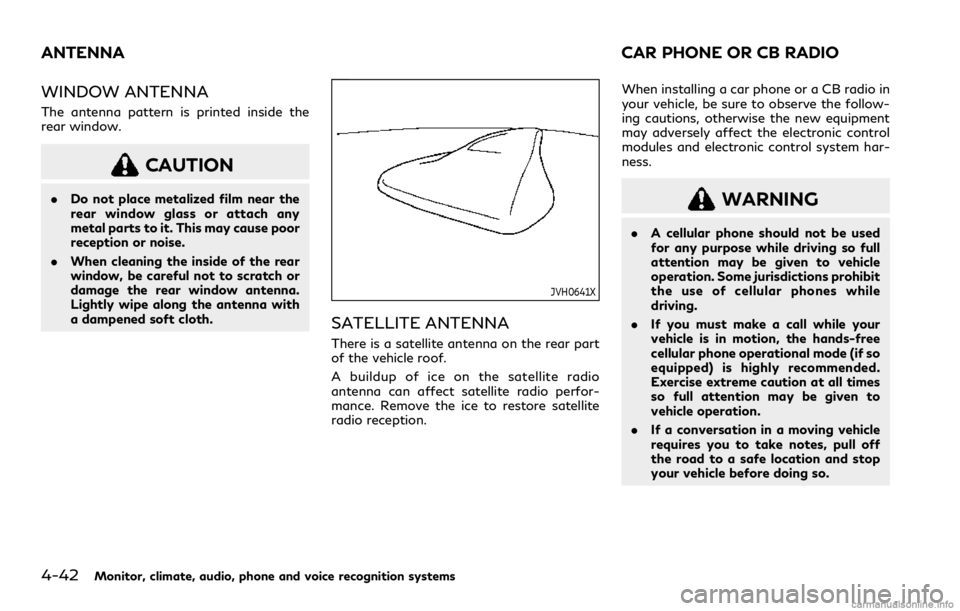
4-42Monitor, climate, audio, phone and voice recognition systems
WINDOW ANTENNA
The antenna pattern is printed inside the
rear window.
CAUTION
.Do not place metalized film near the
rear window glass or attach any
metal parts to it. This may cause poor
reception or noise.
.When cleaning the inside of the rear
window, be careful not to scratch or
damage the rear window antenna.
Lightly wipe along the antenna with
a dampened soft cloth.
JVH0641X
SATELLITE ANTENNA
There is a satellite antenna on the rear part
of the vehicle roof.
A buildup of ice on the satellite radio
antenna can affect satellite radio perfor-
mance. Remove the ice to restore satellite
radio reception.When installing a car phone or a CB radio in
your vehicle, be sure to observe the follow-
ing cautions, otherwise the new equipment
may adversely affect the electronic control
modules and electronic control system har-
ness.
WARNING
.A cellular phone should not be used
for any purpose while driving so full
attention may be given to vehicle
operation. Some jurisdictions prohibit
the use of cellular phones while
driving.
.If you must make a call while your
vehicle is in motion, the hands-free
cellular phone operational mode (if so
equipped) is highly recommended.
Exercise extreme caution at all times
so full attention may be given to
vehicle operation.
.If a conversation in a moving vehicle
requires you to take notes, pull off
the road to a safe location and stop
your vehicle before doing so.
ANTENNA CAR PHONE OR CB RADIO
Page 221 of 492
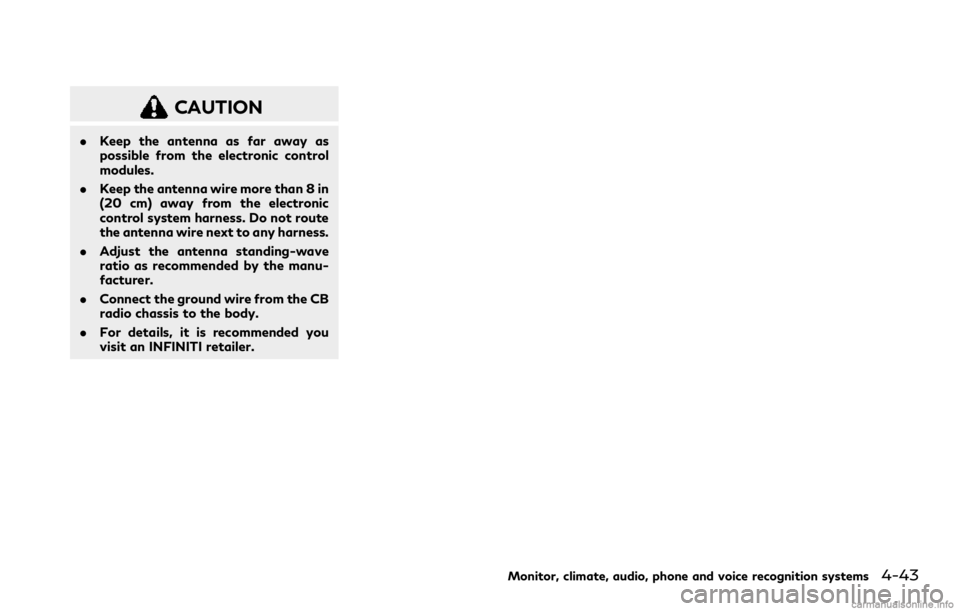
CAUTION
.Keep the antenna as far away as
possible from the electronic control
modules.
.Keep the antenna wire more than 8 in
(20 cm) away from the electronic
control system harness. Do not route
the antenna wire next to any harness.
.Adjust the antenna standing-wave
ratio as recommended by the manu-
facturer.
.Connect the ground wire from the CB
radio chassis to the body.
.For details, it is recommended you
visit an INFINITI retailer.
Monitor, climate, audio, phone and voice recognition systems4-43
Page 377 of 492
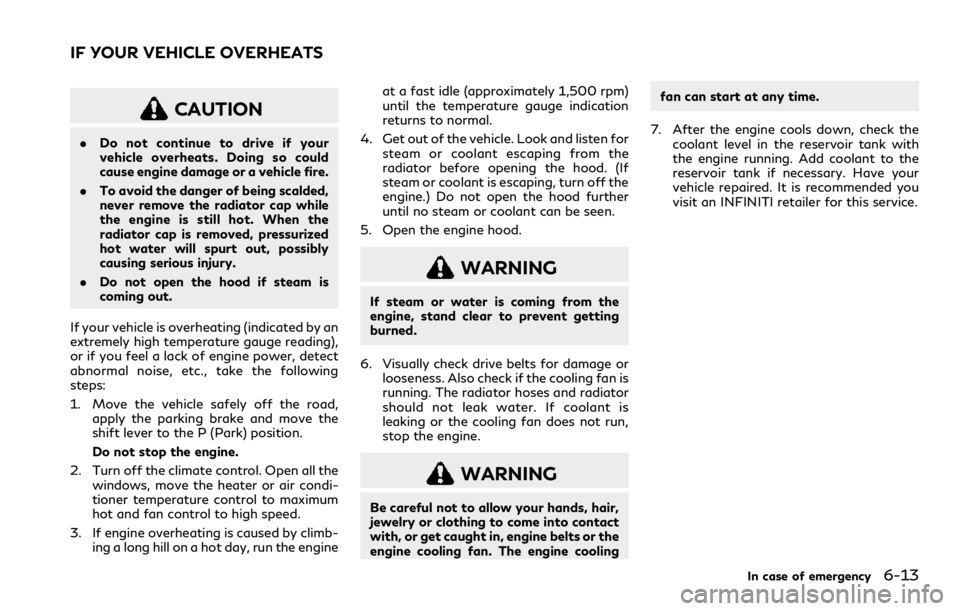
CAUTION
.Do not continue to drive if your
vehicle overheats. Doing so could
cause engine damage or a vehicle fire.
.To avoid the danger of being scalded,
never remove the radiator cap while
the engine is still hot. When the
radiator cap is removed, pressurized
hot water will spurt out, possibly
causing serious injury.
.Do not open the hood if steam is
coming out.
If your vehicle is overheating (indicated by an
extremely high temperature gauge reading),
or if you feel a lack of engine power, detect
abnormal noise, etc., take the following
steps:
1. Move the vehicle safely off the road,
apply the parking brake and move the
shift lever to the P (Park) position.
Do not stop the engine.
2. Turn off the climate control. Open all the
windows, move the heater or air condi-
tioner temperature control to maximum
hot and fan control to high speed.
3. If engine overheating is caused by climb-
ing a long hill on a hot day, run the engineat a fast idle (approximately 1,500 rpm)
until the temperature gauge indication
returns to normal.
4. Get out of the vehicle. Look and listen for
steam or coolant escaping from the
radiator before opening the hood. (If
steam or coolant is escaping, turn off the
engine.) Do not open the hood further
until no steam or coolant can be seen.
5. Open the engine hood.
WARNING
If steam or water is coming from the
engine, stand clear to prevent getting
burned.
6. Visually check drive belts for damage or
looseness. Also check if the cooling fan is
running. The radiator hoses and radiator
should not leak water. If coolant is
leaking or the cooling fan does not run,
stop the engine.
WARNING
Be careful not to allow your hands, hair,
jewelry or clothing to come into contact
with, or get caught in, engine belts or the
engine cooling fan. The engine coolingfan can start at any time.
7. After the engine cools down, check the
coolant level in the reservoir tank with
the engine running. Add coolant to the
reservoir tank if necessary. Have your
vehicle repaired. It is recommended you
visit an INFINITI retailer for this service.
In case of emergency6-13
IF YOUR VEHICLE OVERHEATS
Page 470 of 492
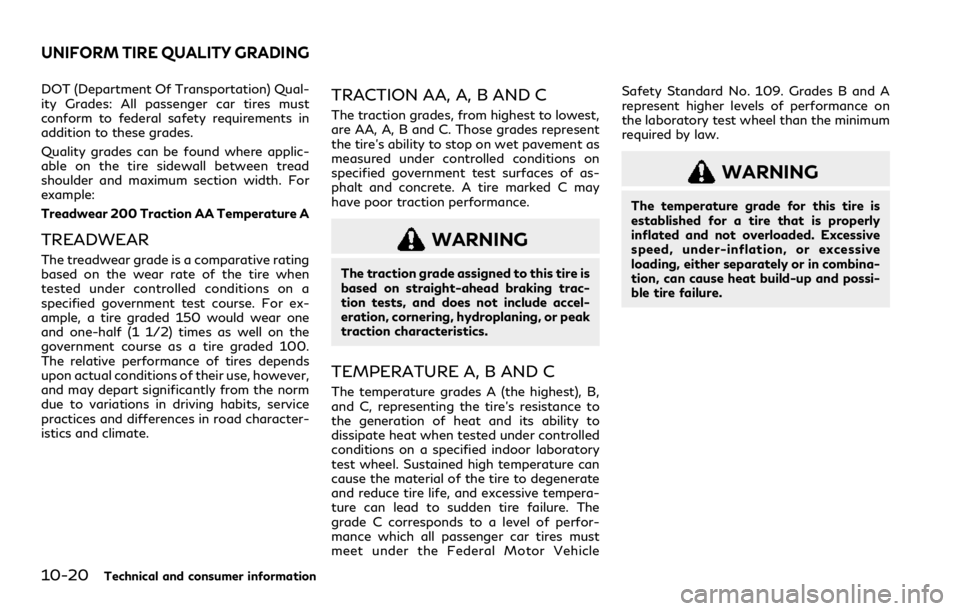
10-20Technical and consumer information
DOT (Department Of Transportation) Qual-
ity Grades: All passenger car tires must
conform to federal safety requirements in
addition to these grades.
Quality grades can be found where applic-
able on the tire sidewall between tread
shoulder and maximum section width. For
example:
Treadwear 200 Traction AA Temperature A
TREADWEAR
The treadwear grade is a comparative rating
based on the wear rate of the tire when
tested under controlled conditions on a
specified government test course. For ex-
ample, a tire graded 150 would wear one
and one-half (1 1/2) times as well on the
government course as a tire graded 100.
The relative performance of tires depends
upon actual conditions of their use, however,
and may depart significantly from the norm
due to variations in driving habits, service
practices and differences in road character-
istics and climate.
TRACTION AA, A, B AND C
The traction grades, from highest to lowest,
are AA, A, B and C. Those grades represent
the tire’s ability to stop on wet pavement as
measured under controlled conditions on
specified government test surfaces of as-
phalt and concrete. A tire marked C may
have poor traction performance.
WARNING
The traction grade assigned to this tire is
based on straight-ahead braking trac-
tion tests, and does not include accel-
eration, cornering, hydroplaning, or peak
traction characteristics.
TEMPERATURE A, B AND C
The temperature grades A (the highest), B,
and C, representing the tire’s resistance to
the generation of heat and its ability to
dissipate heat when tested under controlled
conditions on a specified indoor laboratory
test wheel. Sustained high temperature can
cause the material of the tire to degenerate
and reduce tire life, and excessive tempera-
ture can lead to sudden tire failure. The
grade C corresponds to a level of perfor-
mance which all passenger car tires must
meet under the Federal Motor VehicleSafety Standard No. 109. Grades B and A
represent higher levels of performance on
the laboratory test wheel than the minimum
required by law.
WARNING
The temperature grade for this tire is
established for a tire that is properly
inflated and not overloaded. Excessive
speed, under-inflation, or excessive
loading, either separately or in combina-
tion, can cause heat build-up and possi-
ble tire failure.
UNIFORM TIRE QUALITY GRADING
Page 478 of 492
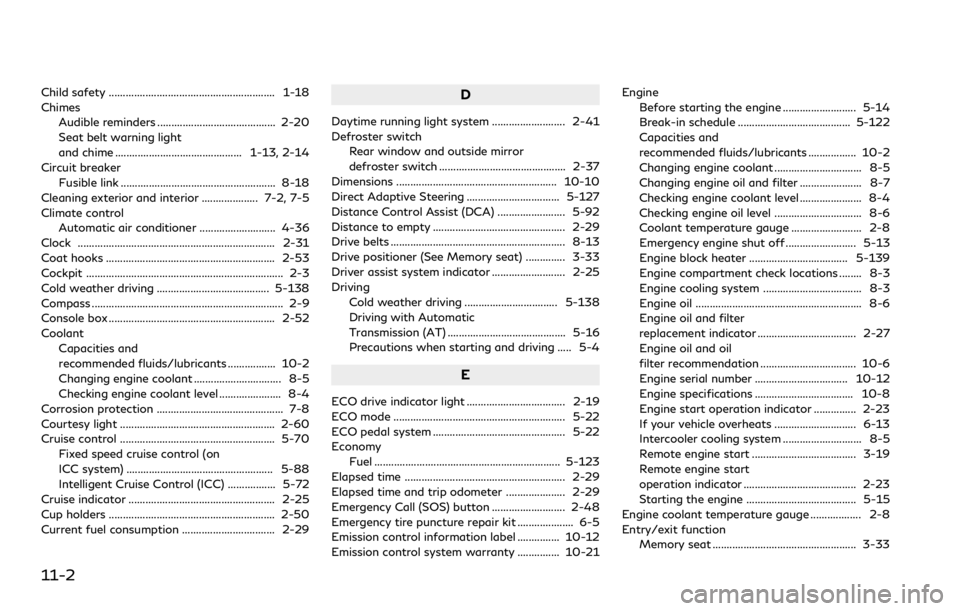
11-2
Child safety ........................................................... 1-18
Chimes
Audible reminders .......................................... 2-20
Seat belt warning light
and chime ............................................. 1-13, 2-14
Circuit breaker
Fusible link ....................................................... 8-18
Cleaning exterior and interior .................... 7-2, 7-5
Climate control
Automatic air conditioner ........................... 4-36
Clock ...................................................................... 2-31
Coat hooks ............................................................ 2-53
Cockpit ...................................................................... 2-3
Cold weather driving ........................................ 5-138
Compass .................................................................... 2-9
Console box ........................................................... 2-52
Coolant
Capacities and
recommended fluids/lubricants ................. 10-2
Changing engine coolant ............................... 8-5
Checking engine coolant level ...................... 8-4
Corrosion protection ............................................. 7-8
Courtesy light ....................................................... 2-60
Cruise control ....................................................... 5-70
Fixed speed cruise control (on
ICC system) .................................................... 5-88
Intelligent Cruise Control (ICC) ................. 5-72
Cruise indicator .................................................... 2-25
Cup holders ........................................................... 2-50
Current fuel consumption ................................. 2-29D
Daytime running light system .......................... 2-41
Defroster switch
Rear window and outside mirror
defroster switch ............................................. 2-37
Dimensions ......................................................... 10-10
Direct Adaptive Steering ................................. 5-127
Distance Control Assist (DCA) ........................ 5-92
Distance to empty ............................................... 2-29
Drive belts .............................................................. 8-13
Drive positioner (See Memory seat) .............. 3-33
Driver assist system indicator .......................... 2-25
Driving
Cold weather driving ................................. 5-138
Driving with Automatic
Transmission (AT) .......................................... 5-16
Precautions when starting and driving ..... 5-4
E
ECO drive indicator light ................................... 2-19
ECO mode ............................................................. 5-22
ECO pedal system ............................................... 5-22
Economy
Fuel .................................................................. 5-123
Elapsed time ......................................................... 2-29
Elapsed time and trip odometer ..................... 2-29
Emergency Call (SOS) button .......................... 2-48
Emergency tire puncture repair kit .................... 6-5
Emission control information label ............... 10-12
Emission control system warranty ............... 10-21Engine
Before starting the engine .......................... 5-14
Break-in schedule ........................................ 5-122
Capacities and
recommended fluids/lubricants ................. 10-2
Changing engine coolant ............................... 8-5
Changing engine oil and filter ...................... 8-7
Checking engine coolant level ...................... 8-4
Checking engine oil level ............................... 8-6
Coolant temperature gauge ......................... 2-8
Emergency engine shut off ......................... 5-13
Engine block heater ................................... 5-139
Engine compartment check locations ........ 8-3
Engine cooling system ................................... 8-3
Engine oil ........................................................... 8-6
Engine oil and filter
replacement indicator ................................... 2-27
Engine oil and oil
filter recommendation .................................. 10-6
Engine serial number ................................. 10-12
Engine specifications ................................... 10-8
Engine start operation indicator ............... 2-23
If your vehicle overheats ............................. 6-13
Intercooler cooling system ............................ 8-5
Remote engine start ..................................... 3-19
Remote engine start
operation indicator ........................................ 2-23
Starting the engine ....................................... 5-15
Engine coolant temperature gauge .................. 2-8
Entry/exit function
Memory seat ................................................... 3-33